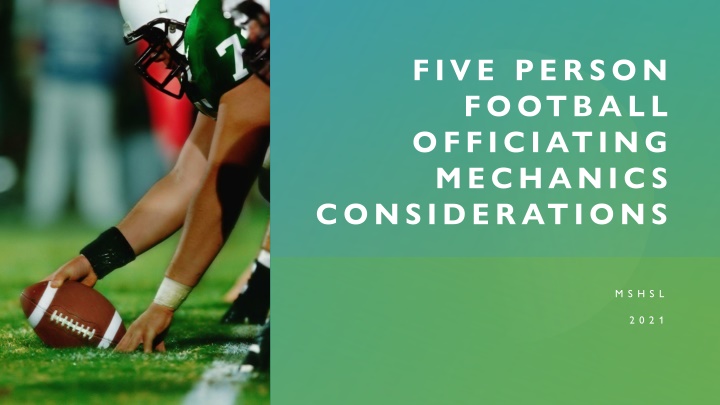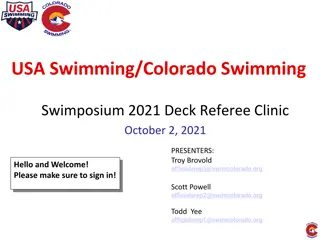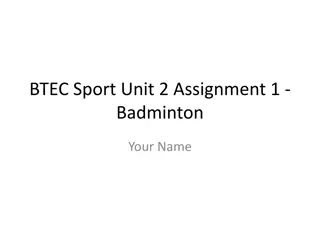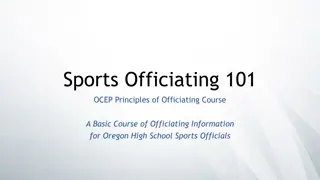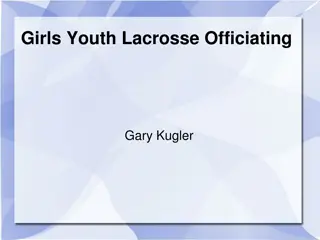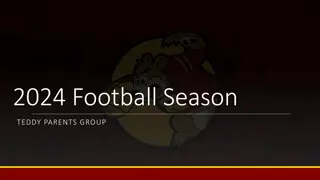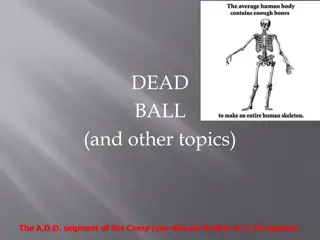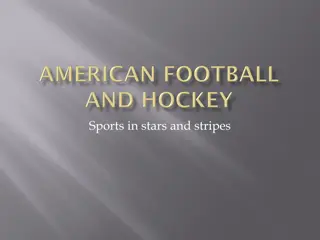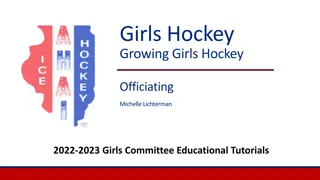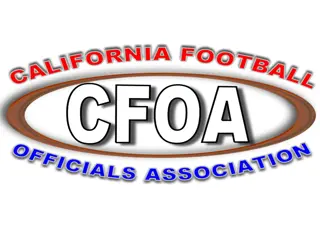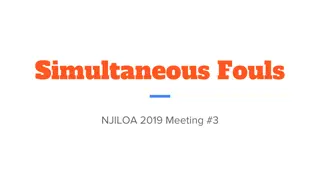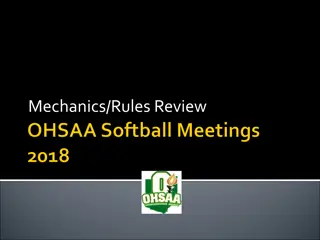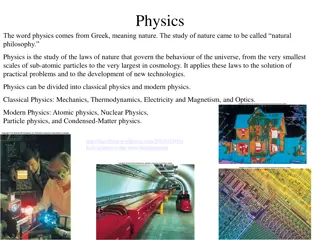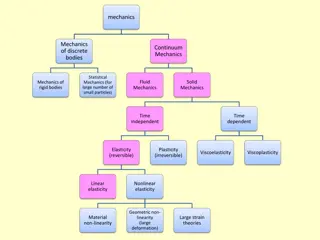Five-Person Football Officiating Mechanics Considerations in MSHSL 2.0.2.1
Explore the essential mechanics for football officiating, covering aspects such as referee and umpire positioning, player counting, zone warnings, and clock awareness. Enhance coverage accuracy and minimize missed opportunities for safety fouls in both offensive and defensive plays. Get insights from experienced clinicians and observers in the MSHSL Officiating Program to elevate your game officiating skills.
Download Presentation

Please find below an Image/Link to download the presentation.
The content on the website is provided AS IS for your information and personal use only. It may not be sold, licensed, or shared on other websites without obtaining consent from the author.If you encounter any issues during the download, it is possible that the publisher has removed the file from their server.
You are allowed to download the files provided on this website for personal or commercial use, subject to the condition that they are used lawfully. All files are the property of their respective owners.
The content on the website is provided AS IS for your information and personal use only. It may not be sold, licensed, or shared on other websites without obtaining consent from the author.
E N D
Presentation Transcript
FIVE PERSON FOOTBALL OFFICIATING MECHANICS CONSIDERATIONS M S H S L 2 0 2 1
Mike Spanier Bill Mills Rich Stolp Paul McDonald Mike Graf Jason Nickleby Pam Inniger Charter Clinicians Observers MSHSL Officiating Program
W H Y C H A N G E ? Always looking to provide better coverage Fewer Higher accuracy on Offensive/Defensive Holding opportunities for missed safety fouls
Referees Count players before Team A breaks the huddle or as early as possible without a huddle Positioned to the right of the QB at least as wide as the Tight End 13-15 yards deep Guard and Tackle on the right side are your initial keys (area of responsibility) as well as backs in your vision S C R I M M AG E P L AY S
Umpires Count players before Team A breaks the huddle or as early as possible without a huddle Positioned to the left of the QB at the left foot of the left tackle 14 yards deep Center, Guard and Tackle on the left side are your initial keys (area of responsibility) as well as backs in your vision S C R I M M AG E P L AY S
LOS Count players if possible Positioned one yard outside the sideline at a minimum Watch for obvious movement of restricted linemen, particularly the tackle on your side Rule on legality of formations Warn zone Obvious Fouls Know H/L Mechanics Adjustments S C R I M M AG E P L AY S
Back Judge Count Team B players B approximately 20 yards unless the ball is inside the 15 High emphasis on clock awareness (crew) L Game Clock B Play Clock S C R I M M AG E P L AY S
Referees Observe action behind the line and the runner to the neutral zone with a focus on the right side of the line If you read run to the right or up the middle, focus on the blocks at the POA If you read run to the left, focus on the blocks on the backside For this year, stick with the QB wherever they go Assist with spotting/relaying the ball S C R I M M AG E P L AY S R U N N I N G P L AY
Umpires Observe action at the line and threatened runners with a focus on the left side of the line If you read run to the left or up the middle, focus on the blocks at the POA If you read run to the right, focus on the blocks on the backside For this year, allow the QB to pass you if they scramble to the side zone Make your way to the inbounds spot after clearing dead ball responsibilities S C R I M M AG E P L AY S R U N N I N G P L AY
LOS Observe the initial action by or to the offensive player who is your key, especially if pressed If you read run to your side, focus on the blocks at the POA Determine forward progress when you have a clear view of the ball For plays that go away from you, clean up backside S C R I M M AG E P L AY S R U N N I N G P L AY
Back Judge Observe the initial action by or to the offensive player who is your key, especially if pressed Pause, read and react. Do not bail. Be ready for crackback blocks Your vision should be at POA blocks in both side zones Do not get the football until you clear the dead ball responsibilities Help with second level blocks up the middle and fouls in the area of the pile S C R I M M AG E P L AY S R U N N I N G P L AY
Referees Observe action behind the line with a focus on the right side of the line When the QB is a threat to be fouled, adjust your vision to the QB Be aware of the tackle box as this is your piece of ING If the quarterback leaves the pocket, officiate inside-out For this year, you will be the primary judge on legality of contact with the quarterback S C R I M M AG E P L AY S PA S S I N G P L AY
Umpires Observe action behind the line with a focus on the left side of the line When the QB is a threat to be fouled, adjust your vision to the area around the QB Be aware of the tackle box If the quarterback leaves the pocket, maintain your vision on blocks For this year, you will be secondary on legality of contact with the quarterback For this year, allow the QB to pass you if they scramble to the side zone Make your way to the inbounds spot after clearing dead ball responsibilities on most plays S C R I M M AG E P L AY S PA S S I N G P L AY
LOS Observe the initial action by or to the offensive player who is your key, especially if pressed If you read pass, your initial key has priority, but move to the tackle if your receiver is not threatened Hold the line until the pass is imminent Limit movement at the time of the pass Primary for IDP, with the weak side LOS having the best view For plays that go away from you, clean up backside S C R I M M AG E P L AY S PA S S I N G P L AY
Back Judge Observe the initial action by or to the offensive player who is your key, especially if pressed Pause, read and react. Do not bail If you read pass, move to zone coverage quickly and all eyes to the ball on a pass Primary on catch/no catch on long pass plays Do not get the football until you clear the dead ball responsibilities Help with second level blocks and fouls in the area of the pile S C R I M M AG E P L AY S PA S S I N G P L AY
Referees If a running play ends in your side zone, prepare to triangle the ball into the umpire If a running play ends in the umpire s side zone for a loss, prepare to spot the ball When the umpire has the ball in their hands, start the game clock if required Scan the field for flags/subs/injuries, indicate a first down when needed S C R I M M AG E P L AY S S P OT T I N G T H E B A L L & PAC E
Umpires Move to the inbounds spot on plays that end in a side zone and the B will triangle the ball to you On a tackle for loss in your side zone, prepare to triangle the ball to the referee for spotting On a run or completed pass middle third of the field, prepare to retrieve the ball for spotting Keep a similar pace for the whole game (unless under 2:00 in the 2nd/4th quarter and time is a factor) Our goal is to get the ball on the ground between :28 and :32 on the PC Maybe more time needed on a long pass play, but do not put the ball down early as that is the expected pace for the remainder of the game If we go too fast, we make mistakes as do the players Going too fast can lead to injuries Keep the lateral position on a down indicator (1, 2, 3, 4, 5 or LH, LM, M, RM, RH) Place the ball on a spot that you can easily enforce penalties from S C R I M M AG E P L AY S S P OT T I N G T H E B A L L & PAC E
LOS Mark forward progress Don t be too finite Officiate players, do not worry about the exact blade of grass that a spot is on Place the ball at your feet if the play ends in your side zone Pinch hard on critical spots in the field of play if you are not sure on a TD/safety Ask for the ball and place it exactly when the LTG is threatened S C R I M M AG E P L AY S S P OT T I N G T H E B A L L & PAC E
Back Judge Accordion in when the play is over Do not get the football until you clear the dead ball responsibilities Help with fouls in the area of the pile Make sure that the R has clock status as necessary Make sure that clocks are correct when needed Do not be overly technical on delay of game be very deliberate in starting the PC S C R I M M AG E P L AY S S P OT T I N G T H E B A L L & PAC E
FREE KICKS Same initial positioning two yards off the sideline at the back edge of the box Count players for K and R before putting the ball in play Same coverages and mechanics as in the past Once the ball is kicked, U and B need to let K cross their face before coming onto the field LOS hold your position until the GL is no longer threatened Zone coverage for all officials, but don t leave a threat
Referees Initial position 8-10 yards wide of the ball and 3- 4 yards behind the punter Aware of numbering exceptions to the right side When the punter is a threat to be fouled, adjust your vision to the punter Be aware of the tackle box as this is your piece of ING If the punter leaves the tackle box, officiate inside-out For this year, you will be the primary judge on legality of contact with the punter S C R I M M AG E K I C K S P U N T S
Umpires Initial position normal TE position and 3-4 yards behind the punter Initial vision on the snapper and then transition to blocks Aware of numbering exceptions to the left side and the snapper When the punter is a threat to be fouled, adjust your vision to the area around the punter View the second wave blocks as K progresses downfield S C R I M M AG E K I C K S P U N T S
LOS Observe the initial action by or to the K players in your area of responsibility, especially if pressed Legality of formation/FST H - Wait for the ball to be kicked before vacating the line H - View the second wave blocks as K progresses downfield L Release at the snap but officiate the first wave of blocks L Take the receiver if the ball is in your third of the field Get a new ball after clearing your dead ball responsibilities S C R I M M AG E K I C K S P U N T S
Back Judge Observe the initial action by or to the kicking team player who is your key, especially if pressed Line up evenly approximately 5 yards behind the deepest receiver shading to the chains side Start at the goal line if it can be reasonably threatened Hold the dead ball spot until cleared by the U Help with the first wave of blocks unless you have KCI responsibilities in the middle or chains side zone S C R I M M AG E K I C K S P U N T S
Same mechanics as in previous years Remember that scrimmage kick rules apply on unsuccessful field goal attempts S C R I M M AG E K I C K S S C O R I N G K I C K S
OFFICIATING MECHANIC S CONSIDERATIONS Put yourself in the best and safest position to officiate Concentrate on your space and MIBT Very thankful for all of you! Have a GREAT season!
